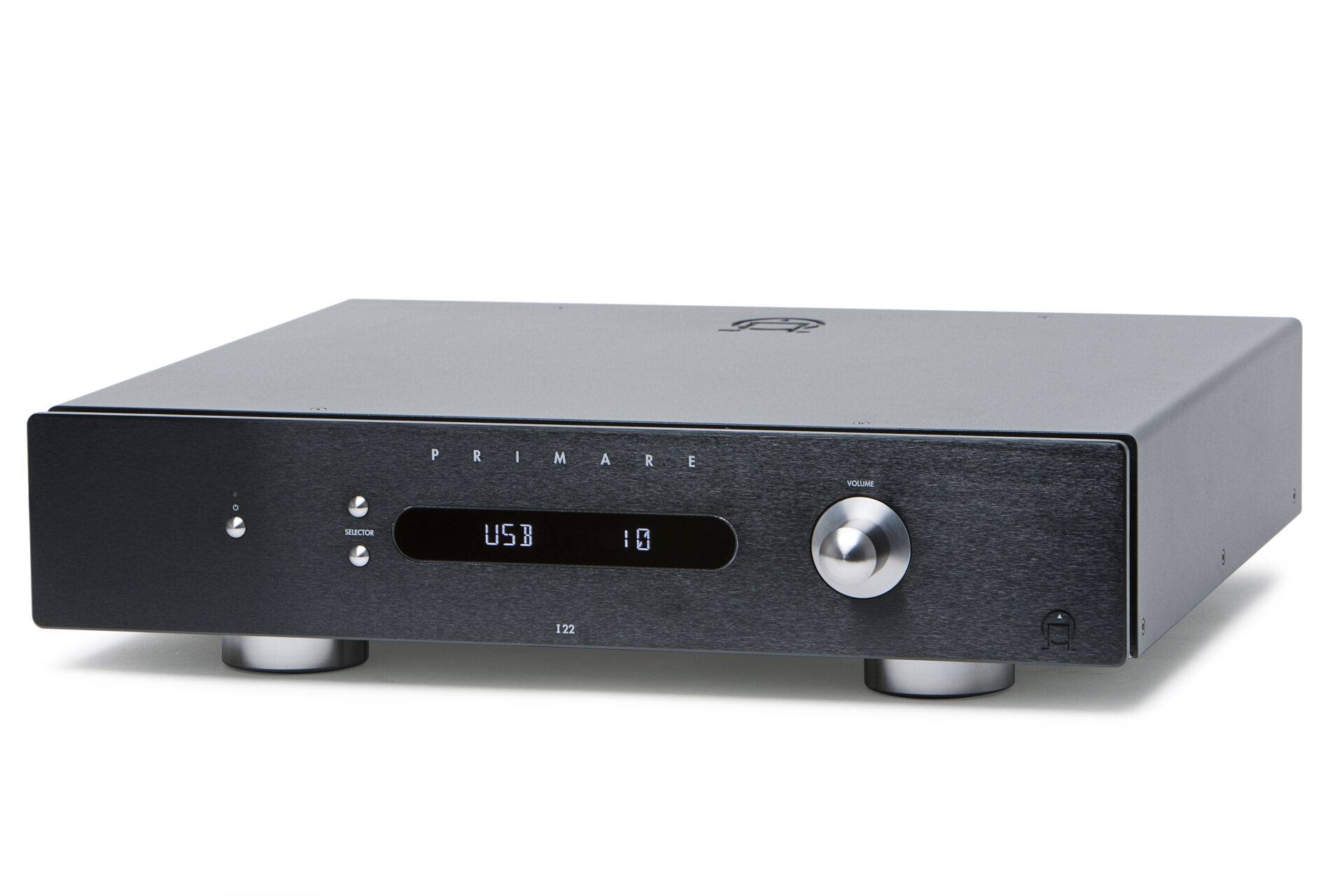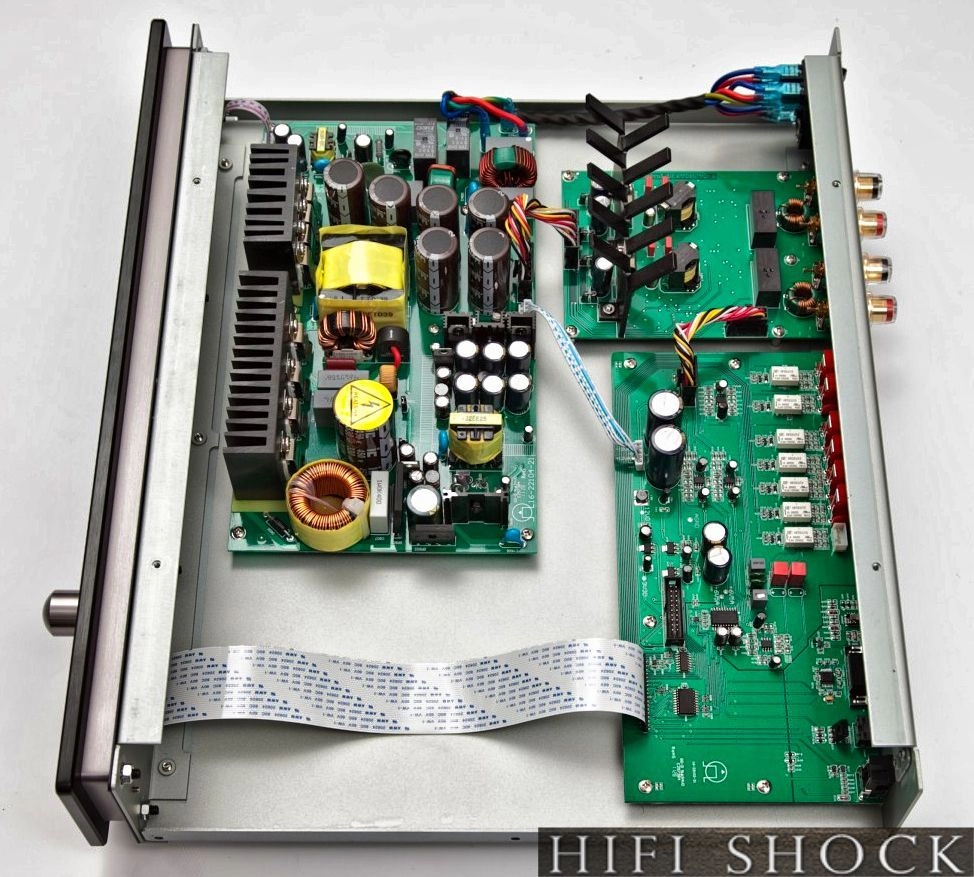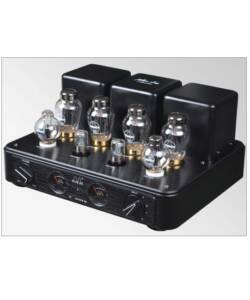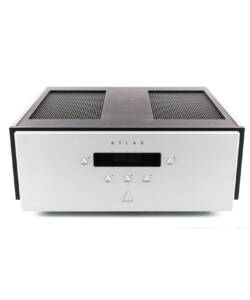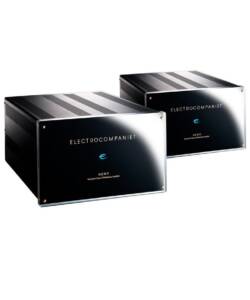Primare I22 Integrated Amplifier (Black)
Original price was: R76,000.00.R26,000.00Current price is: R26,000.00.
A complete package
Ever since my youth I have found myself more naturally drawn to speakers than the components that drive them. My first real hifi purchase, many years ago, was a pair of DM602 S2 by Bowers & Wilkins. I really didn’t know anything at that stage about speakers per se, but as I came from a musical background, playing piano, trombone (briefly, it must be said), and guitar, I knew what I liked. I was in my “rock” stage, and enamored with INXS, and I needed something to pump out “What you need” off their “Listen Like Thieves” album that I had on vinyl. In the years that followed, those speakers accompanied me through numerous setups, culminating in their use as near-field monitors when I started working as a sound engineer. In the end, they failed, quite badly at that task, and were relegated to the home connected to the Rotel pre and power amps I had bought a few months after their original purchase. In my world of sound engineering, amps were often after thoughts, particularly in the near-field monitoring scenario I mostly found myself in. Powered monitors had begun to rule the roost, but I settled on a pair of passive concentric Tannoys powered by a Bryston power amp that ran out of the “tape” return stereo mix on my desk. During that time I rarely took notice of the changing world of hifi amplifiers, while maintaining a somewhat unhealthy obsession with auditioning countless speakers of all types. After moving on from my sound engineering days, the B&Ws remained, whilst everything else was either returned to their owners or sold off. The Rotel setup powering my speakers also remained in tow, and I dragged this around for many years.
This long preamble goes some way to explaining why, in the end, I couldn’t put up with the Rotel amps. The DM602 is an unforgiving speaker, it ruthlessly transmits distortion in the signal path, and the woofers can struggle to stay in shape if the amp is having a hard time with the source. They also have a non-linear response, hence their lack of usefulness in the studio environment, but can sound amazing if driven with clean linear power through the amplification stage. The Rotels just didn’t cut it, to my ear, and after a long romance they departed for another owner. I was now left running the DM602s through my Onkyo AVR, a poor choice for music, but after so many years obsessing over music I just couldn’t muster the energy to do anything about it. That is, until I walked into Miranda Hifi and asked Angus about turntable choices. He walked me through several options, and after discussing these I remembered that, not having the Rotels on hand, I would need an appropriate amplification stage to setup the Rega RP3 I had my eye on (I still do, but that is another story). After showing me a few options, including Rotel, he pointed out the Primare.
The Primare i22 is a fairly innocuous looking beast, but is built like the proverbial. Machined and polished, I felt like standing on it to see if it was up for the Pepsi challenge. Having spent many, many, many hours listening to high quality near-field monitors, I new what I like, but I was also realistic about my options in the domestic environment. I new the DM602s were at the low end of the hifi scale, but also new that driven properly they could produce a relatively open sound stage and good dynamics and timbre down to about 100Hz (at which point there is a steep roll off). The choices available at the Primare i22 price-range are somewhat daunting, but the first step was to understand how the Primare D-class amplification stage worked. Primare, in this and their other D-class stages, pre and post (though some of their power amplification range still rely on A/B-class push pull) are D-class from the power input stage right through to the pre and power amplification. The power stage in the i22 is a switching power supply, notoriously noisy, and the amplification likewise relies on a switching amplification. However, D-class amplification has improved significantly since the early days, driven no doubt by computers and mobile phones which rely on D-class amplification for their efficiency, relatively small size, and low heat transmission. A little research on the web quickly convinced me that the quality of the output from the Primare was not derived from copious amounts of LPF at the output stage, but a proprietary technology that kept the power running the amplification stage pure into the power amp, and another set of LPF at the amplification stage that cleaned distortion at each “switch”, rather than at the output. I was convinced by the technology, but how did they sound after some careful listening.
The first thing that struck me about the Primare i22 was its capacity to relay dynamics. I listened to them on the BW PM1s and Sonus Faber Venere 2.5s and settled on the later as a better match. I knew that my own speakers wouldn’t match the depth of the Veneres, nor look quite as elegant! Nonetheless I was convinced that if there were any funny-business in the amp stage, the Veneres would let me know.
The other draw card on the Primare i22 is the included DAC with three inputs, coaxial, toslink (both at 192k/24bit), and asynchronous usb (96k/24bit). While this is marketed as an optional upgrade Miranda Hifi had them installed as standard. Now of course there are many good reasons for buying a separate DAC, however the onboard DAC was at least as good as a variety of AD Converters that I listened to in the sub $800 category, and at the price seemed a bargain. Besides, I can always upgrade later.

In the store I spent several sessions listening to a variety of music. My personal favorite, Pieter Wispelwey’s second recording of Bach’s Cello suite, is my go to when auditioning speakers, and thus I relied heavily on that for initial impressions. This particular recording is very closely mic’ed and the artist relays every breath, chair movement and finger strike as he plays what I believe is the finest rendition of Bach’s Cello suites. The Primare confidently transmitted the information, and after listening to Miles Davis “Kind of blue”, Pink Floyd “Dark Side of the Moon”, and Chopin’s Scherzo for good measure I was sold. A week later the Primare was home, and I began running it in for a week (my partner thinks I am slightly crazy), to let everything settle down. I also brought home an Isotek Evo3, as I was still suspicious of the switching power supplies capacity to handle the noisy environment that is Australian AC power in my apartment.
A week later, after moving my speakers around to capture the best possible soundstage and linear response, which I had never bothered to do with my previous set up running the speakers out of the AVR, I began a serious listening session. I listened from two sources, CD running on my Panasonic Bluray player into the optical input of the Primare, and with an analog connection. And via my Mac Mini which is set up as a dedicated music player running Audirvana Plus. After running the system for a few days I realized that the CD player (via digital) was actually sounding better than my computer. It was as if a sheet was in front of the speakers when running through the computer. All things being equal I suspected the USB cable, which was a “cheap and cheerful” that I had picked up somewhere over the years. I swapped it out for a Wireworld Ultraviolet and suddenly not only were the highs more open and expansive, the mids and lows also ran cleaner when pushed hard. Thank goodness for that!
I began with Chopin Scherzo 1-4, pushing the speakers reasonably hard, but not so hard that my room would become too much of a factor in the listening experience. Well it was, a noticeable bloom around 150Hz that was mudding the mix. Half an hour of moving furniture, stacking pillows and ottomans, and draping blankets I was satisfied. Not perfect, and at the danger point for domestic harmony if my partner walked back into the apartment, but good enough to dampen the resonance. A by-product of my maneuvering was an increased definition in the highs; of course, one goes with the other.
I returned to some serious and critical listening, and the first thing I noticed about the Primare i22 was, in a word, “air”. The sound-stage was open and airy without being dry, with lovely definition that began to touch on the nirvana of a three-dimensional listening space. I desperately wanted to try the amp in this room with the Sonus Fabers but that will have to wait. If you are like me, and a little old-school when it comes to amps, forget everything you thought about class-D amplification when it is the hands of the engineers at Primare (and Devialet, which is another story). The highs were faultless, and my speaker’s tweeters began deforming long before the amplifier could get close. At seriously neighbor annoying listening levels, the Primare just purred along. Classical, rock, jazz, metal, it coped with all types of dynamics and frequency changes. From the deep thumping bass of Tool’s “Vicarious”, to the almost over-bearing shimmering highs on the late Jeff Buckley’s “Last goodbye”, the Primare soaked up the pressure and asked for more. I seriously doubt this is only an 80W per channel amplifier, probably closer to 100Wpc.
My staple recording of Wispelwey’s Cello Suites was open and airy, the timbre on the Cello was a delight, and every breath and finger tap was detailed and brought the music into the room. At low levels, the Primare did a remarkable job of transmitting a linear frequency response, but it really needs to be pushed about “30” on the volume knob to bring the speakers I have to life. Chopin’s Scherzo’s danced around the living room, and I promptly forgot that I was supposed to be listening with a critical ear. Pink Floyd’s “Time”, a desperately good track for sorting out bass response and open sound-staging, was detailed and broad, while dynamically the Primare dutifully kept up. I kept listening, and kept throwing more challenges at the Primare. Tool, Opeth, Lamb of God; Bach, Chopin, Vivaldi, and some remarkable piano recitals by Marc-Andre Hamelin; and finally a bit of Lorde, Wilsen, Amy Winehouse, and Emily Barker. The Primare is as flexible as it is compact in size and features. My last test was Jazz, if it can’t keep up with Miles and Coltrane it was going straight back to the shop. I began with “Kind of Blue” and went on a journey that involved the Mahavishnu Ochestra (when I’m playing “Apocalypse” I know I have left the critical ear stage and am just enjoying myself), and ended with Billy Cobham. All good, the Primare kept pumping out the sound, and I lost all track of time.
In the end a couple of minor points kept popping up. Firstly the USB DAC is good, but not great. If you listening to a lot of computer based tracks like I do, then you will be soon scoping outboard options. For the money, it is good value and does a great job, but if, like me, you are a little obsessed with AD/DA convertors, you will be trying to justify the $1500+ price tag for the higher end of the market. Of course, if you can afford that kind of outlay you might be better of with the Pimare i32, which is more powerful and lacks the “standard” ADC. Of course it is another step in price. Another factor, which I suspect is another “money will fix it” problem, is the lack of dynamics and timbre at low volumes. While the Primare i22 did a great job of opening the sound stage, it still lacked a little presence when it wasn’t pushing the speakers. This is, of course, a problem with the speakers as much as the amp, so if you spend a lot of time listening to music at low levels (particularly classical), take your speakers along for the auditioning process. Personally I don’t mind, as I will switch to cans when it is time to keep the volume low. Nonetheless it is a factor.
Overall the Primare i22, for the money, is the complete package (sans phono input, which may or may not be an important factor). It is loud enough for any bookshelf, and ‘most’ smaller to mid-sized floor standing speakers (eg. Sonus Faber Venere 2.5). Do audition with your own speakers if you are not sure though. At 80Wpc with good quality ADC for the money, and plenty of analog inputs, it is a good entry point integrated amp if you are exploring the audiophile side of hifi for the first time. Or if, like me, you are always loathe spending too much on home hifi when you could be building your own studio with the stuff. Or…whatever, it is great, relatively cheap, and with a computer or CD player and appropriate set of speakers, sounds amazing. Commence tweaking!
Primare I22 IntegratedOne Sleek Swede
By Jeff Dorgay
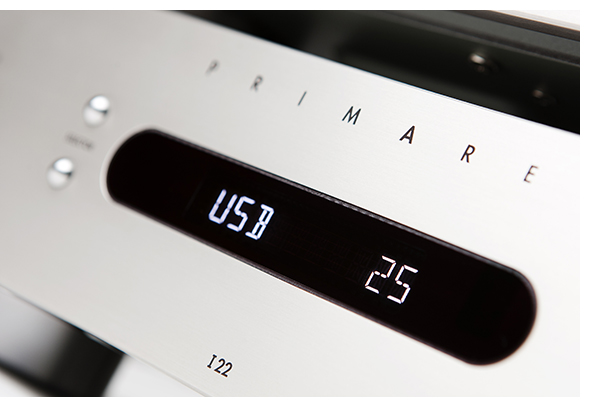 Incorporating a DAC inside an integrated amplifier has been going on for some time now, with mixed results, and the Primare I22 is a product arguably aimed more at the music lover who likes to keep things simple.
Incorporating a DAC inside an integrated amplifier has been going on for some time now, with mixed results, and the Primare I22 is a product arguably aimed more at the music lover who likes to keep things simple.
The I22 pictured here includes the $799 DAC board (with 24/96 USB and 24/192 Toslink and SPDIF inputs) for $2,498. Those of you already in possession of a good DAC can order your I22 without DAC for $1,799 and those on the fence can add the board later for $799, without a huge financial penalty.
While aimed at a consumer who will probably spend $1,000 – $4,000 on a pair of speakers to round out a system, the I22 is well at home driving the $35,000 KEF Blades. Its 80 watts per channel prove more than adequate to really rock the orange KEF flagship speakers.
Taking advantage of Primare’s UFPD (Ultra Fast Power Device) technology, which combines the Class D amplification stage and output filters into a single device, the claimed sonic improvements are readily apparent: This is a thoroughly modern Class D design, which suffers from none of the sonic artifacts that characterize (and often plague) this configuration.
Listening to the multi-layered vocals of 10cc’s “Marriage Bureau” is a treat – all of the late ’70s multitrack wizardry is in full effect, including the great Moog synthesizer tracks, with everything well sorted and keeping its own distinct sonic space.
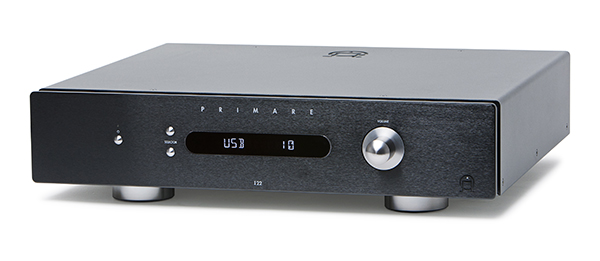 The ins and outs
The ins and outs
The front panel is the essence of understatement, with a single volume control, flanked by a pale white LED indicator panel, displaying the input in use along with the volume level. Just to the right is a pair of small, machined buttons to select input, and one more to switch between standby and power-on mode. Incidentally, this might be counterintuitive to some, as the LED glows when the I22 is in standby mode, extinguishing when the amplifier is on.
Inputs 1-5 are standard line level inputs with RCA jacks and inputs 6–8 are digital inputs (if you’ve had the DAC board installed), with a Toslink, USB and SPDIF. For the duration of the review, we used the Meridian Control 15 server via SPDIF and the Aurender A10 server via USB. The majority of the files used were 16 bit/44.1, with a bit of dallying into the world of high res. Hardcore audiophiles might squeal about the lack of 24/192 USB capability (or DSD for that matter, but I’m not the least bit concerned); however, for those streaming files from a laptop or other digital source, primarily of CD and MP3 quality, the I22 will be just fine as it is. Should the highest resolution digital files be your priority, order the I22 without the DAC board, or just use an SPDIF converter with your laptop. Pairing a Mac Book Pro with the M-Tech USB converter recently reviewed worked perfectly, requiring only a minimal investment of $179.
Setup takes but a second to unbox; connect speakers and source and you’re rocking – it couldn’t be easier. Though it might not be important to some, the I22 is lusciously understated and feels considerably more expensive than its modest price tag might suggest.
 Like every other Class D amplifier we’ve tested, the I22 does respond incredibly well to an upgraded power cord and line conditioning. Adding a power cord and the EVO 3 line conditioner from ISO TEK removes a layer of glare and cloudiness that you might mistake for the sonic signature of the amplifier, giving the I22 an even smoother, more natural sound.
Like every other Class D amplifier we’ve tested, the I22 does respond incredibly well to an upgraded power cord and line conditioning. Adding a power cord and the EVO 3 line conditioner from ISO TEK removes a layer of glare and cloudiness that you might mistake for the sonic signature of the amplifier, giving the I22 an even smoother, more natural sound.
Resolution without regret
Both Carole King’s Tapestry and Daft Punk’s Random Access Memories, downloaded via HD Tracks easily illustrate the onboard DACs ability to resolve the difference between standard and high-resolution files. An even better demo was evident with Roberta Flack and Donny Hathaway’s self-titled album, also in 24/192. Both vocalists occupied their own space, delicately layered upon each other, with a delightful smoothness – again offering higher than expected for the price asked.
The deep low-frequency content in the Daft Punk album focuses on a primary strength of Class D amplifiers – bass response, providing equally solid heft and control. This is very impressive with the KEF Blades, but even more so with the $1,499/pair LS-50s which really come alive via the I22, exhibiting tremendous LF response.
Equally compelling is the rendition of analog tracks, captured to 24/96, via my Nagra LB studio recorder, using the AVID Acutus Reference SP/Lyra Atlas/Indigo Qualia analog front end. Again, resolution takes a big jump for the better, i.e. more natural, underscoring the overall sonic performance of the onboard DAC. Sifting through a series of recent digital captures from the Music Matters Jazz Blue Note catalog makes it even easier to listen to the amount of texture the I22 is capable of rendering when the source material is up to the task.
Finally, combining a Rega RP6 turntable and Exact cartridge via the latest tube phonostage from Monk Audio (12AX7 powered, $1,195 MSRP) rounds the system out nicely for those wanting to make the foray into analog without breaking the bank. Spinning Daniel Lanois’s Black Dub album, chock full of acoustic and electronic texture, proves how smooth this amplifier is capable of sounding. While you wouldn’t mistake it for a valve amplifier, it is in no way harsh; in fact, a number of audiophile buddies didn’t know it was a Class D design until it was revealed.
The second track on the Lanois album, “I Believe In You,” features some great drum sounds, that are all captured with excellent depth, texture, speed and delicacy – especially with the brush work via drummer Brian Blades. Many Class D designs have a tendency to sound somewhat thin in the sense of a two dimensional soundstage, yet here the Primare does very well. Lead vocalist Trixie Whitley has always stood out in front of the soundstage, as she does on my reference system. Comparing this to a somewhat similarly priced PrimaLuna tubed integrated, the tubes definitely throw a more three dimensional soundfield, but in comparison to similarly priced solid state kit, the I22 more than holds its own. And you don’t have to screw around with vacuum tubes, either.
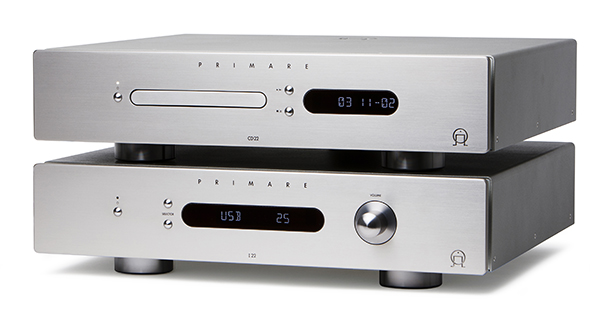 Simple, stylish, sonic excellence
Simple, stylish, sonic excellence
Those wanting bells and whistles should look elsewhere. However, if you want great sound wrapped in an understated enclosure that will not call much attention to itself, I can’t think of a better choice than the Primare I22. Now, the only thing you need decide is if you want it in silver or black, and whether you’d like the DAC board or simply use the matching (and equally enticing) C22 CD player. We are very happy to award this amplifier one of our Exceptional Value Awards for 2013 – even more so, with the DAC installed.
The Primare I22 Integrated Amplifier
MSRP: $1,799
$2,498 (with DAC)
Description
Specifications
Power output: 80 watts per channel into 8Ω (stereo)
Frequency response: 10Hz to 20kHz
Total harmonic distortion: 0.05%
Signal to noise ratio: 95dB (line)
Digital inputs: coaxial, optical, USB
Dimensions: 430 x 420 x 106mm
Weight: 10kg
Finish: black, titanium
Accessories: C23 remote control

